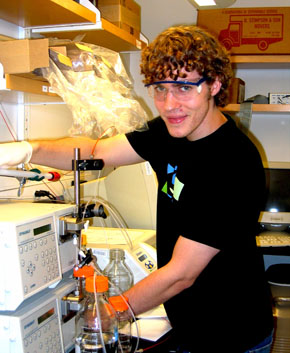
Devin Dersh
Massachusetts Institute of Technology
Stubbe Laboratory
Mentor: Jun Wang
Summer 2007
Sml1, Small Protein Inhibitor of S. cerevisiae Ribonucleotide Reductase
Ribonucleotide reductase (RNR) catalyzes the reduction of ribonucleotides to deoxyribonucleotides. This essential enzyme helps maintain the pools of nucleotides at specific concentrations in the resting cell but is also upregulated during times of DNA replication and repair. One mode of regulation is the small, mostly-unfolded protein Sml1, which binds to a, the catalytic subunit of RNR, and inhibits activity. Sml1 is poorly characterized and difficult to track, so site directed mutagenesis was used to create mutants with cysteine resides in and around a proposed area of binding. These cysteine residues provided a way to bind BADAN, an environmentally sensitive fluorescent probe. Fluorescence titrations were conducted with the labeled Sml1 mutants and a to observe changes in the intensity of fluorescence as well as the maximum wavelength shift, which correspond to changes that the BADAN molecules are exposed to. In addition, the oligomeric state of a needs to be determined before the fluorescence data can be fully understood. Different effectors, such as TTP, dGTP, and dATP can affect the oligomeric state of a and thus binding conditions for Sml1. A Superdex 200 column on the HPLC is being used to determine a system in which only one species is present. Once this is done, titrations can be performed on a variety of different conditions to determine the mechanism of binding, binding constants, and other information regarding the Sml1-a interaction.